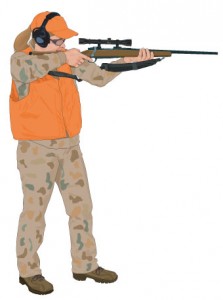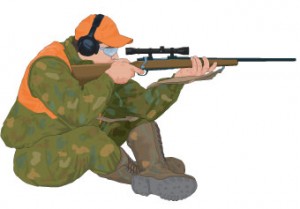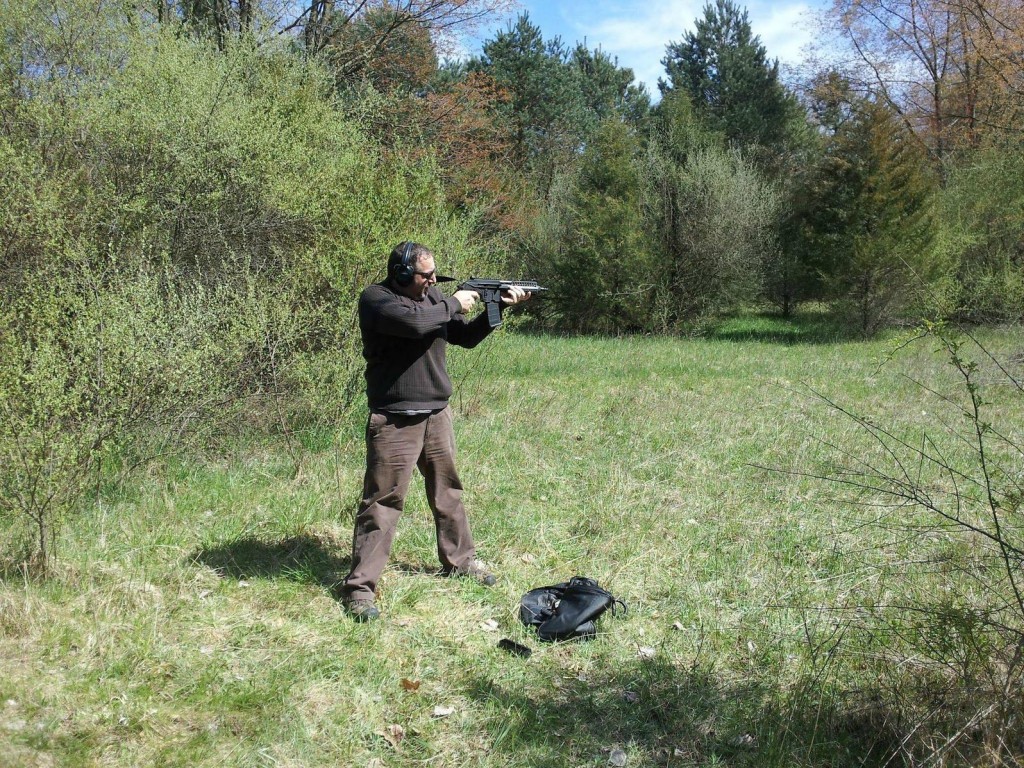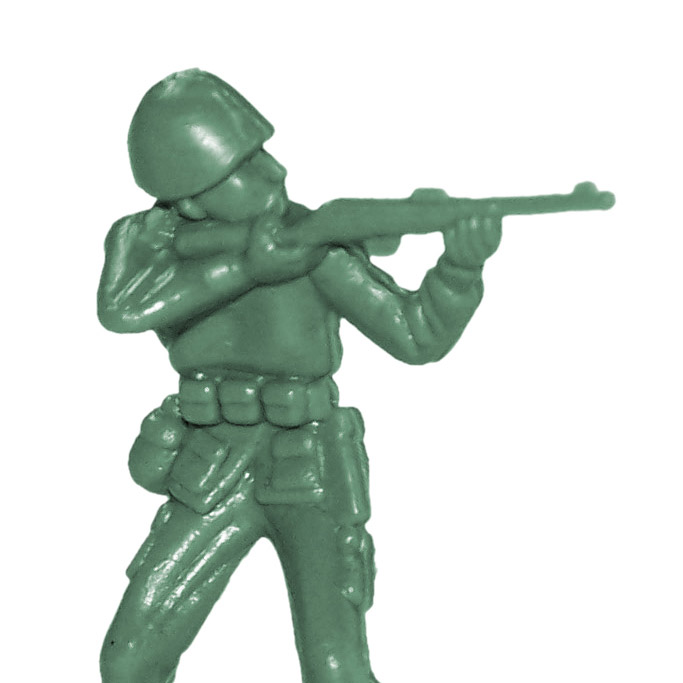As I sat at the range packing up my gear, I watched a father telling his son about the four common shooting positions for his rifle: standing, kneeling, sitting, and prone. I was pleased that this boy’s father was passing on useful knowledge, but I could not help thinking that a lot of people have no idea about these, so I wanted to give our readers a more in-depth look at rifle shooting.
Many shooters will sight in their firearms by using the bench shooting position. This is also a great shooting position to learn rifle and pistol shooters skills. You will find that having your firearm placed in such a stable position allows for greater trigger control and sight alignment. Working from this position should help you master those items and can greatly improve you abilities when you proceed to the four common shooting positions.
 STANDING. STABILITY RATING POOR
STANDING. STABILITY RATING POOR
Standing, also known as “offhand” shooting. This position seems self-explanatory right? You stand there, you shoot, but the looks can be deceiving. It takes some concentration and practice to do it well. It by far is the least steadiest of all positions. The reason this is, is the fact that you have no support other than your own strength and balance. Holding a relatively light weight rifle for any length of time will cause fatigue. It is however the quickest position to assume and is useful for quick shots and for shooting over objects.
PRO TIP: Do not use the sling for support in this position.
Ok you should start off by pointing the left side of your body at the target (if you are right handed). Place your left foot slightly to the right of the target. Place both feet about shoulder-width apart. Raise the rifle up to the firing position, being careful to bring the rifle to your face rather than bending your head down to the rifle. Place your left upper-arm against your body resting it against your ribs. Your left hand should support, not grip, the rifle just forward of the magazine well. Hold the rifle firmly but relaxed in your right hand with your elbow almost horizontal. Snug the butt of the rifle into the pocket of your shoulder created by your right arm. The rifle should be almost but not quite parallel with the width of your body (approximately 2 to 5 degree angle). A slight rearward lean is acceptable to help balance the rifle. Establish a firm spot or cheek weld and align the sights.
You may notice a bit of sway in this position, It’s normal and there’s not much you can do about it. The trick is learning to control the sway and fire when you’re at your steadiest.
As you inhale your spine will compress making the standing position as stable as it can be. So time your shots according to your breathing pattern.
What ideally happens is that the left arm is braced against the rib, letting the bones support the weight of the rifle. The feet and legs are balancing the weight of your body, and the spine is stiffening when you exhale thus increasing the stability of the position. Boom, you may not be as steady as a plastic green army man, but you are much taller (and less green)

KNEELING: STABILITY RATING GOOD
This is where you are on one knee, and it is a very useful position. The steadiness comes from your left arm supported on your left knee that is being steadied by the grounding. This position can be almost as steady as the prone position.
PRO TIP: Use a sling for this position.
Place your left leg toward the target with your foot pointing to the right (approximately 20 to 30 degrees). Tuck your right leg underneath your butt, with the bone of the right cheek resting on the heel.
Place your left elbow just behind your left knee on the inside thigh muscle. (An alternative to this is to place your elbow just forward of the knee, letting the upper triceps rest on the knee itself). Your left arm should support the rifle from almost directly underneath, and your left hand cradling the rifle a little forward of the magazine well. Your right arm should be extended away from the body and the rifle snugged into the pocket of the shoulder. You’ll have to bend forward slightly to achieve a good spot or cheek weld. The sling should provide enough support that the weight of the rifle is not handled by your muscles.
Ideally the weight of the rifle is supported by your properly slung arm, which is steadied by your left leg. Your balance point is between your left foot, right knee and right heel but just slightly forward.
 SITTING: STABILITY RATING GOOD
SITTING: STABILITY RATING GOOD
This position is relatively easy to get into and provides clearance for low- to medium-height obstacles that would interfere with the prone position. There are three variations to the sitting position: open leg, cross leg and cross ankle. All of them are useful and you should find the one that suits you best.
OPEN LEG
Sit down with your body pointing slightly to the right of the target (about 30 degrees). Extend your legs and keep them slightly bent. Your feet should be about shoulder width apart but your knees may extend a bit wider. Keep your left foot as close to flat on the ground as you can. Place your left triceps just forward and right of the kneecap in that little hollow formed by the knee bones. Your right elbow should be placed just below the right knee on the inside of the thigh. If necessary draw your right leg in and to the right a little bit to facilitate a rest for your right elbow. Your left hand will be close to, if not touching, the front sling swivel.
CROSS LEG
Sit down with your body pointing slightly to the right of the target (about 30 degrees). Extend your legs and keep them slightly bent. Cross your left leg over your right leg. Your right foot should act as a stop to keep you left leg from sliding. Place your left and right elbows just behind each respective kneecap on the inside of the thigh. Your left hand should be just forward of the chamber of the rifle. This is the most common position when shooting during low light. Many big game hunters prefer the cross leg position when hunting with a semi-automatic rifle like AR15. It allows them to comfortably sight in the night vision scope for AR15 even when shooting from a ground blind or a tree stand.
CROSS ANKLE
Sit down with your body pointing slightly to the right of the target (about 30 degrees). Cross your right leg over your left leg at the ankles and tuck them underneath you. Indian style was what this was called when I was a young ‘un. Place your left and right elbows just behind each respective kneecap on the inside the thigh. Your left hand should be just forward of the chamber of the rifle.
In all the above variations raise the rifle, establish a good spot or cheek weld, snug it into the pocket of your shoulder.
PRO TIP: Use a sling for this position.
When this position is done correctly it can be as steady as shooting from a bench rest. Lie down with your body pointing 10 to 20 degrees to the right of the target. Keep your shoulders square with your spine and your weight on the left side of your body. Keep your left leg straight while drawing your right leg up as if you were going to crawl. Your left elbow should be on the ground just a little left of the rifle and your left lower arm at about a 30 degree angle. Your left hand should be as far forward as you can go and should cradle the rifle. Your right elbow should be slightly out from your body and resting on the ground. Try to keep your head as level with the ground as possible. Snug the rifle into the pocket of your shoulder and establish a good cheek or spot weld.
PRO TIP: Use a sling for this position.
What happens is the rifle is totally supported by your slung-up arm, which has direct support from the ground. Your body is supported by the ground and thus we’ve done all we can to neutralize the body’s unsteadying affects on shooting. Now it’s just a matter of concentrating on the fundamentals of breath control, trigger control, sight picture, etc., which you have mastered while practicing on the bench.
Now look at that handsome guy, with practice and practice … and more practice you are a pro, and can shoot anything this side of 500 yards. Good luck and be safe.




You must be logged in to post a comment.